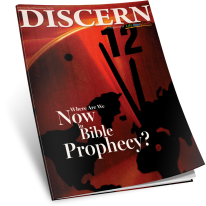The common chronology of Jesus’ death and resurrection directly contradicts Jesus’ own words—and the sign He gave to prove He was the Messiah!

“For as Jonah was three days and three nights in the belly of the great fish, so will the Son of Man be three days and three nights in the heart of the earth” (Matthew 12:40).
In the spring, the majority of the mainstream Christian world celebrates Easter—a holiday that is supposed to commemorate the resurrection of Jesus Christ from the dead. Roughly two days earlier, Good Friday is observed to mark Christ’s death.
These two holidays, nowhere taught in the Bible, are based on the timeline of Christ’s death and resurrection that is accepted by most Christians. Most believe Jesus died on a Friday afternoon and was resurrected as the sun was rising on the next Sunday morning.
It may surprise you that this chronology is not found in the pages of the Bible. In fact, when the Gospel accounts are closely studied, a totally different timeline of these events emerges!
Christ’s own words
A statement made by Jesus Christ, but ignored by the majority of mainstream Christianity, has major implications for this subject.
The scribes and Pharisees were asking Jesus to show them a sign to prove He was who He claimed to be—the Messiah (Matthew 12:38). Jesus had already provided multiple miracles and signs that proved His legitimacy. Jesus refused to perform a miracle on the spot to satisfy their request. He said there would be one sign that would prove whether He truly was the Messiah.
Notice Jesus’ own words: “An evil and adulterous generation seeks after a sign, and no sign will be given to it except the sign of the prophet Jonah” (verse 39, emphasis added throughout).
He then specifically explained this sign: “For as Jonah was three days and three nights in the belly of the great fish, so will the Son of Man be three days and three nights in the heart of the earth” (verse 40).
Jesus’ sign is very specific—that He would be “in the heart of the earth” (in a grave) for three days and three nights.
The implications of the one sign
You may be asking, so what? Why should this statement surprise me?
This statement is so important because it completely invalidates the common Christian chronology of Jesus’ death and resurrection. It is impossible to fit a Friday burial (just before sunset) and a Sunday morning resurrection into the specific time period Jesus gave.
Even if you take “three days and three nights” to mean parts of three days and three nights, here is what you get:
- Friday afternoon Christ is placed in the tomb: a few minutes of daylight.
- Friday night: Night 1.
- Saturday: Day 1.
- Saturday night: Night 2.
- Sunday morning: Christ was already gone from the tomb “while it was still dark” (John 20:1), so no daylight portion can be counted.
The maximum number you can squeeze out of this scenario is one day and two nights (and perhaps a small part of another day)—which would not fulfill the only sign Christ gave.
But cobbling together bits and pieces of days and nights is not the correct way to understand Jesus’ statement in Matthew 12:40. In the parlance of the day, people could either be specific or vague about a period of time they were describing. “Three days” could mean parts of days.
But Jesus Christ’s use of the combination “days” and “nights” made it a statement of precision. The daylight portion of a day was “twelve hours” (John 11:9). The night would also be 12 hours—making the total day 24 hours. When Jesus said “three days and three nights,” He literally meant three distinct 24-hour periods—72 hours!
Jesus had to be in the grave exactly 72 hours to be who He said He was—the Messiah!
When was Jesus’ death and burial?
The accounts of Jesus’ death and resurrection are found toward the end of the four Gospel accounts in the Bible. Each Gospel reveals distinct details about the chronology of events. In order to understand how Christ’s one sign was fulfilled precisely, we have to put information from all four together.
In the Bible, each 24-hour day begins at sunset. Jesus Christ was crucified on the day of the Passover—the 14th of Abib/Nisan on the Jewish calendar. He had eaten the Passover meal the evening before, as prescribed by Leviticus 23:5. Later that night and into the early hours of the morning, He was arrested, tried and convicted in an illegal trial brought about by Jewish and Roman authorities.
The Sabbath immediately following Jesus’ death was a “high day”—an annual holy day, the first day of the Feast of Unleavened Bread (Leviticus 23:6). It was not the weekly Sabbath that always falls on Saturday.
Jesus’ crucifixion began about 9 a.m. and lasted until His death about 3 p.m. (Mark 15:25; Matthew 27:46).
After His death, Christ’s body was given to a man named Joseph of Arimathea. Christ was then placed into a “tomb that was hewn out of the rock” shortly before sunset (Luke 23:53-54).
Many are confused about the day of Christ’s crucifixion, thinking it was Friday because Mark 15:42 says that the day He died and was placed in the tomb was “the day before the Sabbath.” The assumption is that this “Sabbath” was the weekly Sabbath, which is from Friday sunset to Saturday sunset. If this were the case, however, there would have been no way Jesus could have fulfilled His one sign precisely the way He said He would—because we know He was already risen by Sunday morning.
The key is found in the Gospel of John.
Notice what John writes about the day following Jesus’ death: “Therefore, because it was the Preparation Day, that the bodies should not remain on the cross on the Sabbath (for that Sabbath was a high day)” (John 19:31).
The Sabbath immediately following Jesus’ death was a “high day”—an annual holy day, the first day of the Feast of Unleavened Bread (Leviticus 23:6). It was not the weekly Sabbath that always falls on Saturday. In the year of Christ’s death, the first day of Unleavened Bread fell on a Thursday.
That puts the Passover and Jesus Christ’s crucifixion on the day before the holy day—on Wednesday.
This is further proven by the fact that the Gospel accounts reveal that there were two Sabbaths within the three-day and three-night period that Jesus was in the grave: the annual high day (Thursday) and the weekly Sabbath (Saturday).
Notice this important detail recorded in Mark: “Now when the Sabbath was past, Mary Magdalene, Mary the mother of James, and Salome bought spices, that they might come and anoint Him” (Mark 16:1). The key is that they purchased the spices after the Sabbath had ended.
Luke records another fact that sheds more light: “Then they [the women] returned and prepared spices and fragrant oils. And they rested on the Sabbath according to the commandment” (Luke 23:56). Here, Luke shows that they prepared the spices and afterward rested on “the Sabbath.”
We have two distinct Sabbaths being spoken of in these verses, because we read that the women bought the spices after the Sabbath, but prepared them before they kept the Sabbath! That is impossible if it is just one day!
These verses confirm that there were two Sabbaths within the three days and three nights.
The timing of Christ’s resurrection
Now that we understand that Christ died and was entombed shortly before sunset on a Wednesday, all we have to do is count forward three days and three nights to determine the time of His resurrection.
- Wednesday (night): Night 1.
- Thursday (day): Day 1.
- Thursday (night): Night 2.
- Friday (day): Day 2.
- Friday (night): Night 3.
- Saturday (day): Day 3.
So Jesus Christ’s resurrection was on Saturday afternoon—just as the sun was setting.
Many misinterpret the Gospel accounts of the resurrection as saying that He was resurrected early on Sunday morning. But go back and read them closely. None of them say that! All the Gospel accounts say is that He was already risen by the time the women returned to the tomb on early Sunday morning. They had started out from home while it was still dark (John 20:1) and arrived at the tomb close to sunrise (Matthew 28:1-6; Mark 16:2-7; Luke 24:1-3).
Jesus had been resurrected hours earlier, before sunset Saturday night. It was not until the following Sunday morning that His resurrection was discovered and made known by the angel sitting on the stone.
The implications
The majority of Christianity believes in an incorrect timeline of Jesus Christ’s crucifixion and resurrection. Some may see this as an insignificant detail. But it’s important to consider the implications:
- Christ’s only sign to the evil generation to prove He was the Messiah was the specific length of time He said He would be in the grave—three days and three nights. If we reject that He fulfilled that sign precisely as He said He would, we would be forced to reject Jesus as the Messiah. Understanding the exact fulfillment gives us confidence that Jesus was who He said He was—the Messiah and Son of God.
- Understanding the proper chronology of the death and resurrection of Christ helps us to discern the errors of the two primary holidays that the majority of Christianity keeps to commemorate those days—Good Friday and Easter Sunday. We should understand that not only are those days not found in the Bible, but they are based on an incorrect understanding of the death and resurrection of Christ.
- Studying the chronology in the Gospels teaches us that the followers of Christ continued to keep both God’s annual festivals and the weekly Sabbath. These are the days that God intends us to use to worship Him.
This is another example of the majority of Christianity believing something that is totally contrary to the words of Jesus Christ. This “Christ vs. Christianity” series will continue to show where modern Christianity deviates from the true teachings of Jesus Christ.
Keep reading and discerning.
For more on this topic, read our article on the sign of Jonah on the LifeHopeandTruth.com website. Also, be sure to read our articles “Resurrection of Jesus: Can We Prove It?” and “Jesus’ Resurrection: Eyewitness Accounts.”





